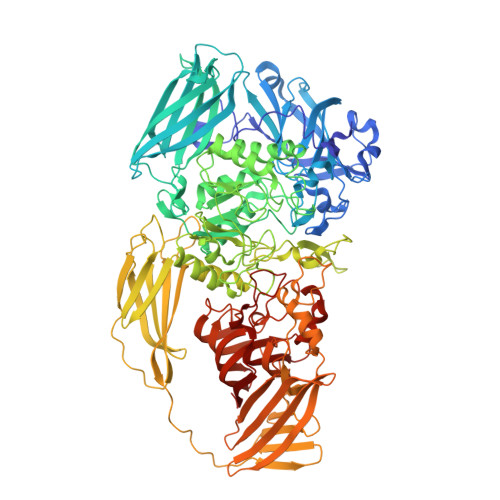Role of Met-542 as a guide for the conformational changes of Phe-601 that occur during the reaction of β-galactosidase (Escherichia coli).
Dugdale, M.L., Dymianiw, D.L., Minhas, B.K., D'Angelo, I., Huber, R.E.(2010) Biochem Cell Biol 88: 861-869
- PubMed: 20921997
- DOI: https://doi.org/10.1139/O10-009
- Primary Citation of Related Structures:
3I3B, 3I3D, 3I3E - PubMed Abstract:
The Met-542 residue of β-galactosidase is important for the enzyme's activity because it acts as a guide for the movement of the benzyl side chain of Phe-601 between two stable positions. This movement occurs in concert with an important conformational change (open vs. closed) of an active site loop (residues 794-803). Phe-601 and Arg-599, which interact with each other via the π electrons of Phe-601 and the guanidium cation of Arg-599, move out of their normal positions and become disordered when Met-542 is replaced by an Ala residue because of the loss of the guide. Since the backbone carbonyl of Phe-601 is a ligand for Na(+), the Na(+) also moves out of its normal position and becomes disordered; the Na(+) binds about 120 times more poorly. In turn, two other Na(+) ligands, Asn-604 and Asp-201, become disordered. A substrate analog (IPTG) restored Arg-599, Phe-601, and Na(+) to their normal open-loop positions, whereas a transition state analog d-galactonolactone) restored them to their normal closed-loop positions. These compounds also restored order to Phe-601, Asn-604, Asp-201, and Na(+). Binding energy was, however, necessary to restore structure and order. The K(s) values of oNPG and pNPG and the competitive K(i) values of substrate analogs were 90-250 times higher than with native enzyme, whereas the competitive K(i) values of transition state analogs were ~3.5-10 times higher. Because of this, the E•S energy level is raised more than the E•transition state energy level and less activation energy is needed for galactosylation. The galactosylation rates (k₂) of M542A-β-galactosidase therefore increase. However, the rate of degalactosylation (k₃) decreased because the E•transition state complex is less stable.
- Department of Biological Sciences, University of Calgary, Calgary, AB T2N 1N4, Canada.
Organizational Affiliation:




















